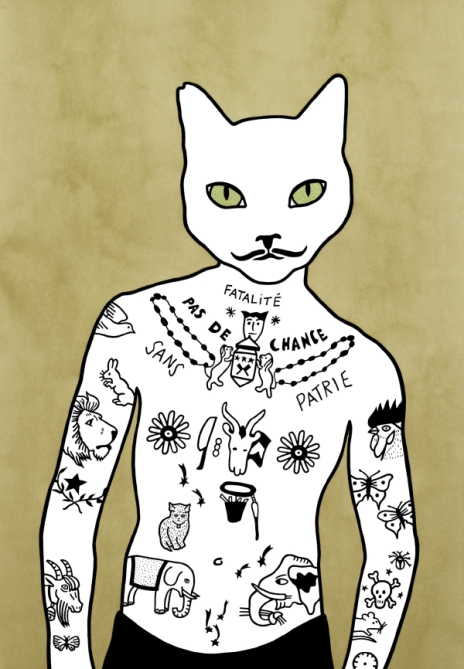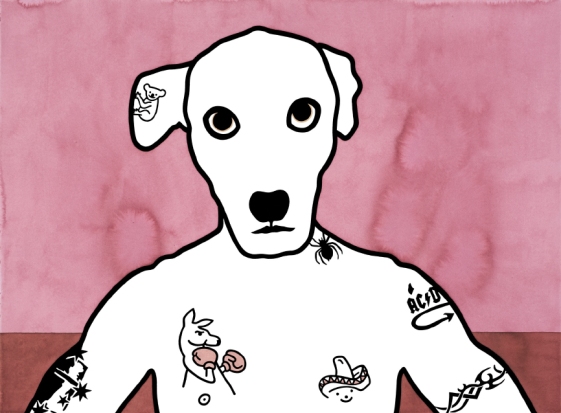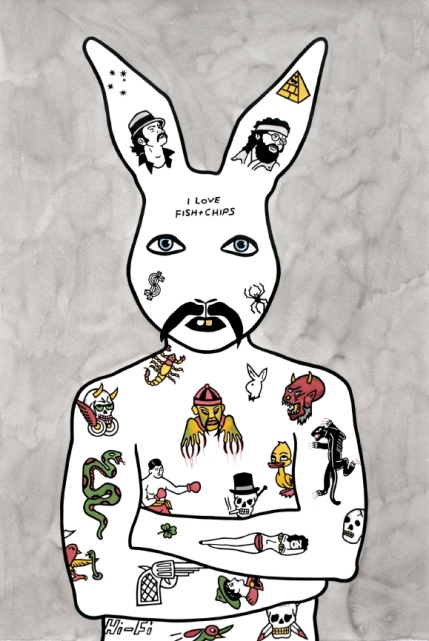This article will feature in the Winter 2015 edition of IMPRINT, the quarterly journal for the Print Council of Australia.
Over the past 20 years Rona Green has developed a lexicon of hybrid creatures that are instantly recognizable as the product of her outlandish imagination. In various forms of printmaking, and more recently through painting, Green has adapted a style of portraiture where human and animal features are blended to embody a host of fictional characters. Their identity is denoted as much by the various tattoos arranged on their stark white expanses of skin, as it is through a menacing tilt of the head, or the steely glint of a wonky eye. Through her skillful manipulation of crisp lines and simplified shapes, Green depicts some highly memorable personas.
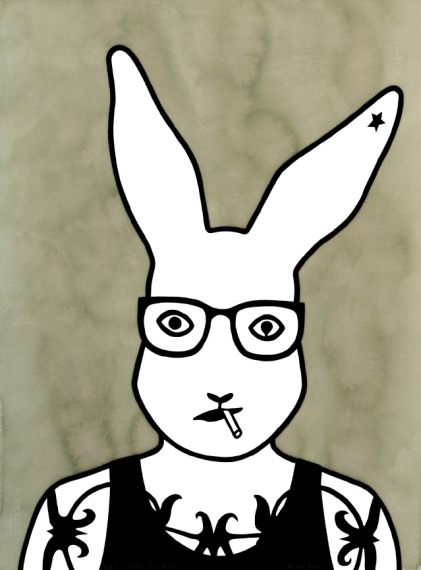
Rona Green, Vilém The Villain, 2013, hand coloured linocut, 76 x 56 cm, edition of 23. Created for the Monstrous print exchange folio project
As an artist, curator, and teacher, Green expresses her creativity not only in her individual practice, but also in the sharing of knowledge required by teaching (along with hosting regular workshops in her Abbotsford Convent studio, Green has taught art and lectured in learning institutions such as RMIT University and Box Hill Institute for a number of years). Her creative impulse also extends to the print exchange portfolios that she has curated on a regular basis for the past 15 years, coordinating their exhibition in various commercial spaces and regional public galleries, and drawing together a network of artists who work in print media. This year will see both Green’s solo art practice and curatorship on show, with an exhibition of prints, drawings and paintings at Australian Galleries in July, and her latest print exchange folio Beastarium on display at Dubbo Regional Gallery in September.
Occasionally, one of Green’s prints, drawings, paintings, or soft sculptures (which she calls poppets) has been inspired by an animal she has met. Most often, however, it will depict a character she has invented. There are a myriad of sources that inform these fictional entities, but they all seem to originate from the periphery of conventional society and hint at various subcultures. Freaks and geeks, baddies and hoons – Green has created a universe populated exclusively by social fringe dwellers. Their otherness is indicated not only by the impossibility of their anthropomorphized animal/human forms, but by the patchwork of tattoos and body markings that only a tattoo aficionado could attempt to decode.
Green writes riddles upon the skin of her inventions. Drawn from numerous sources, her assembled tattoos hint at something about their owner. From the tribal body markings of Borneo and the prison tattoos of Russia’s criminal class, to the popular flash designs readily available in tattoo parlours – each is carefully selected to suggest a backstory for her figures. Green intentionally allows the viewer to speculate on these shady histories, granting plenty of room for individual interpretation. Along with a hefty dose of the absurd, her exaggerated characterisations (that reveal the artist’s love for b-grade horror films and cheesy pop culture) contribute to the playfulness inherent in the work. This diffuses the darker human stories behind her troubled entities, as the viewer may ponder how they got that scar, or lost that limb…
While Green’s figures emerge from outside of polite society, they often take the form of domestic animals that many of us may have owned at one point. Most frequently, dogs, cats and rabbits appear, with cockatoos, seagulls and roosters also common. Green intentionally works with species from the animal world that viewers are likely to have had personal contact with at one time or another.[1] This generates a sense of familiarity, perhaps making them easier to empathise with despite their uncanny appearance.
Green has made monotypes, screenprints, lithographs, and digital prints, however she most frequently works with linocut. Here she introduces a painterly application of hand-colour to her editioned prints. This effectively contrasts with the stark precision of her clean printed lines and solid blacks on pristine white paper. Vivid hues of watercolour enliven intricate tattoo designs, while broad washes of drawing ink colour her backgrounds. This creates an atmospheric space in the picture plane, as she manipulates washes to render feathery effects and textural variance.
In both her artistic and curatorial practice, a sense of inclusiveness plays an important role. Not only does Green create a space for the oddballs that populate her prints and paintings, she also provides a platform for another special species of human, the contemporary artist, to get together and participate through the print portfolio exchanges she curates. Since 2000 Green has instigated numerous projects, 20 by the end of 2015, and has involved a substantial number of printmakers through her remarkably prolific endeavors in this field.
Print portfolio exchanges involve a group of artists who each make an edition of prints that are then exchanged, so that each member of the group receives a set of all of the participating artists’ work. Often artist proofs will be made for exhibition and sale. Green’s first experience of a print exchange occurred in the final year of her art degree at Latrobe University, when she took part in one that included her lecturers and technicians such as the late John Robinson (1940-2009), Cameron Fraser and Jacqui Comer. As a student Green recalls the thrill of suddenly owning prints by these teachers whose work she respected and admired. But more so she was impressed by the egalitarian premise of the project, where everyone, students and teachers alike, were placed on the same level platform, adhering to the same set of conditions and exhibited side by side.[2]
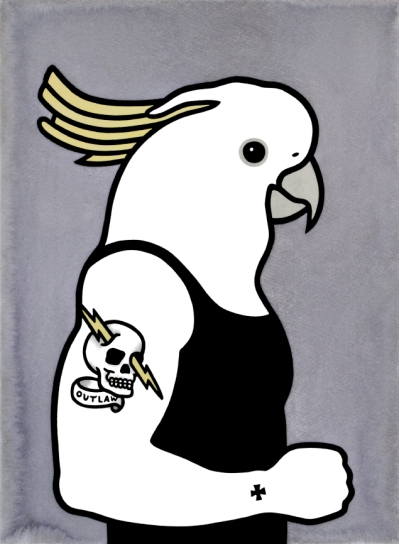
Rona Green, Brett, 2014, hand coloured linocut, 38 x 28 cm, edition of 40. Created for the Beastarium print exchange folio project
Print portfolios remove some of the hierarchies that are so embedded in the machinations of the art-world, that artists who wish to have a professional career have little choice but to operate within. Green invites emerging artists and recent graduates to participate in projects alongside established and senior artists with impressive reputations. Thus those new to the art-world are placed on the same platform as artists whose works are keenly sought after and appreciated. It is little wonder that artists who, particularly in the early stages of their careers, are often hungry for opportunities to make and exhibit work, jump at the invitation to take part in Green’s print exchange projects. Participation provides an opportunity to build networks, share ideas, and contribute to a sense of community that the collaborative nature of printmaking has always engendered.
Green’s efforts also extend to the development of regional museum collections, as in recent years she has coordinated the gift of print portfolios to the institutions where they were exhibited. Geelong Gallery, Charles Sturt University, and Dubbo Regional Gallery all hold her exchange portfolios. It is fair to say that without Green’s independent curatorship, these public collections would not own the work of many of the artists included in the portfolios. Museums and public galleries constrained by budget, or specific curatorial focus, often exclude much that is worthy of representation in public collections. The print projects that Green curates enable the institutions that she works with to capture an exquisite snapshot of contemporary printmaking practice in one neat folio.
Apart from gathering an excellent collection of her own portfolios, Green’s only motive for this consistent and dedicated practice is the creative and communal rewards offered by the projects, which are indeed rich in themselves. She describes the excitement of seeing how each artist has approached a project when the editions start to arrive at her studio to be collated and boxed.[3] Sometimes she will select a broad theme for artists to work with. Often these relate to ideas present within her own work, such as Beastarium (2015), Monstrous (2013), Freak of Nature (2011-12), Altered States (2007) and Beasties (2006). In other projects such as 50 (2007) and 52 (2009) she simply sets the paper size and the artists have free rein to create what they will in any print medium. For larger folios that require bigger editions some artists will work with custom print studios such as Lancaster Press, and a positive effect flows on to printers beyond the exhibiting group.
Embracing the strange, accepting the unfamiliar, and making a place for everyone to belong – there is an underlying thread of fun and generosity that permeates Green’s endeavors in both art making and curatorship. She may be modest in her attitude, but her work in both arenas should not be underestimated for its serious and significant contribution to Australian printmaking.
Marguerite Brown
MAArtCur
Marguerite Brown is an independent arts writer and curator. She has recently completed the Harold Wright Scholarship in Prints & Drawings at the British Museum.
[1] In conversation with the artist, 13th April, 2015.
[2] ibid
[3] ibid
Rona Green: Chancing Your Arm will be exhibited at Australian Galleries, Melbourne from 7 – 26 July 2015
Beastarium will be exhibited at Dubbo Regional Gallery from 19 September – 22 November 2015
For more information about the artist visit www.ronagreen.com
